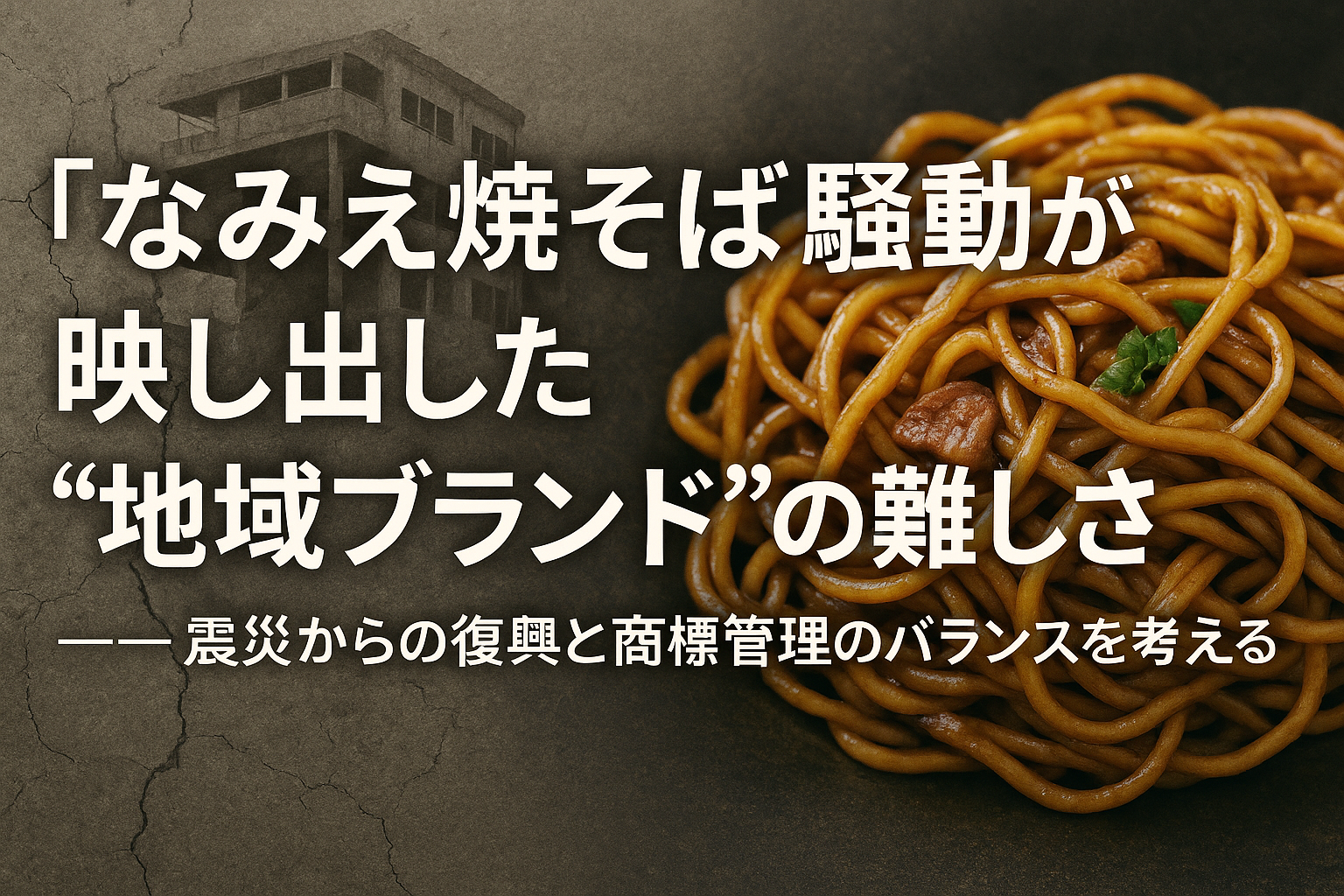A trademark management dispute over Namie Yakisoba, a beloved local specialty of Namie Town in Fukushima Prefecture, has sparked intense debate across social media. Behind this issue lies a difficult question: how should regional brands—symbols of recovery from the 2011 disaster—be protected and nurtured?
This article examines the challenges revealed by the controversy and explores what the future of regional branding should look like.
How Has “Namie Yakisoba” Been Protected?
Namie Yakisoba, considered a symbol of Namie Town’s revitalization efforts, gained nationwide recognition after its appearance at the B-1 Grand Prix.
In 2017, the Namie Town Chamber of Commerce registered it as a regional collective trademark, aiming to maintain its quality and brand value.
Because regional collective trademarks consist of a “region name + product name,” they can be registered without nationwide recognition as long as there is sufficient regional distinctiveness and a certain level of awareness.
While the system is important for regional promotion, it can also lead to friction within the community when management rules change, as seen in this case.
The Trigger: Royalty Fees Imposed on a Long-Established Restaurant
In April 2024, trademark management shifted to an outsourced company. By October, businesses offering the dish were asked to pay:
- Registration fee: 3,000 yen per company
- Royalty: 2.5% of sales
A long-established restaurant, Suginoya, which had served Namie Yakisoba since before the disaster, strongly opposed this.
While continuing operations after evacuating from Namie, the restaurant suddenly received a notice demanding royalty payments. In protest, it changed the menu name to “Suginoya’s Yakisoba” instead of using Namie Yakisoba.
This story spread rapidly on social media, prompting reactions such as:
- “They’re charging royalties even to restaurants that have served it for decades?”
- “No consideration for evacuees?”
Legally, businesses that used a name legitimately before a trademark application are protected by “prior use rights.”
But in this case, the issue was less about legal doctrines and more about community sentiment.
The Chamber of Commerce’s Perspective: “Maintaining a Brand Costs Money”
In its public comments, the Chamber of Commerce openly acknowledged the financial challenges behind its promotional activities, such as:
- Participating in food events
- Creating “Yakisoba Maps”
- Hosting “Yakisoba Summits”
- Food education programs in elementary schools
These efforts have undeniably supported Namie’s recovery and the development of its regional brand.
However, relying on subsidies, sponsorships, and crowdfunding had grown increasingly difficult.
Therefore, the Chamber explained that it had no choice but to seek broader financial contributions in the form of “sponsorship fees” to sustain operations.
A Disconnect Between “Rules” and “Feelings”
What emerges from this controversy is a mismatch between:
- Trademark management as a system, and
- The sentiments of a community that has endured disaster
Chamber of Commerce:
Wants a structured system to maintain the brand
Restaurant operators:
Have long continued the dish through the struggles of recovery
Unexpected financial burdens feel unreasonable
Suginoya in particular had preserved the taste of Namie even while operating in evacuation.
Being suddenly asked to pay fees naturally felt wrong.
Thus, the core of the conflict can be summarized as:
“Legally correct, but emotionally unacceptable.”
The Chamber Apologizes, but a “Gap” Remains
The Chamber of Commerce apologized to Suginoya and reaffirmed that the restaurant could use the name freely.
However, Suginoya decided to continue using “Suginoya’s Yakisoba.”
Behind this decision likely lie:
- A sense of distrust resulting from the controversy
- A desire to rely on its own reputation rather than the trademarked name
Once a rift forms, bridging it is not easy.
Even so, the Chamber is working to rebuild trust by disclosing documents and increasing transparency.
Whether this leads to true reconciliation remains a major challenge.
A Common Dilemma for Regional Brands
This issue is not unique to Namie Yakisoba.
As regional brands gain recognition, communities across Japan face similar questions:
- Who should manage the brand?
- How should costs be shared fairly?
- How should long-established businesses be treated?
- How to balance quality control with the freedom to use the name?
- How to incorporate the context of recovery and regional revitalization?
Regional brands are “shared assets” built by local governments, chambers of commerce, businesses, and residents alike.
Therefore, any change in operating rules requires careful dialogue.
What Is the Future of This “Symbol of Recovery”?
Namie’s population, once 20,000 before the disaster, has now declined to around 2,400.
The town’s long-central commercial district, Shinmachi Shopping Street, is set to close.
Amid these harsh realities, Namie Yakisoba still carries the role of:
- “A flavor that brings back memories of Namie”
- “A symbol of recovery”
If this incident becomes a turning point toward:
- A system local businesses can take pride in
- A shared vision between the Chamber and local restaurants
- Rules that allow participation by supporters outside the region
Then Namie Yakisoba may once again shine as a symbol of community unity.
Conclusion: A Brand Cannot Be Protected by Rules Alone
The strength of a regional brand does not come from legal systems, but from the trust between:
- Those who make it
- Those who sell it
- Those who enjoy it
Though painful, this controversy offers an opportunity to revisit the true meaning of regional brands.
For Namie Yakisoba to remain a source of pride for Namie Town, it may require not only structural reforms but also heartfelt communication.
We will continue to watch Namie’s next steps with great interest.

